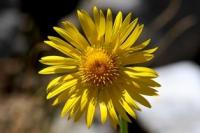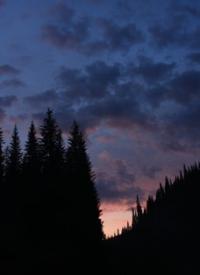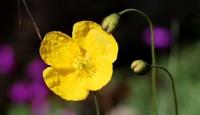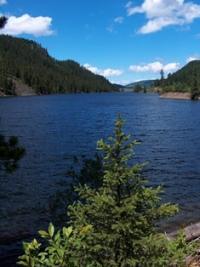Вы здесь
Flora in Terskey Ala-Too.




Wildlife Tours in Kyrgyzstan.
“The earth laughs in flowers.”
Ralph Waldo Emerson.
Flower Tours in Kyrgyzstan.
Climatically related to the orographic and climatic features of the Issyk-Kul region are changes in natural landscapes in the direction from west to east and from bottom to top. The distribution of vegetation and associated soils, as well as animals in the Issyk-Kul basin is characterized by vertical zonality, i.e., is primarily due to the difference in climate at different heights above sea level.
Barskaun-Karakol district of Terskey-Ala-Too has the following zonal characteristics (according to E. Murzaev) (Murzaev E. Central Asia, 1964).
1. Plain and piedmont semi-desert, 1630 - 1850 meters above sea level, mountain-valley soils, light brown and light chestnut, wormwood-grass steppe with shrubs.
2. Piedmont and mid-mountain steppe zone, 1850 - 2100 meters above sea level, mountain chestnut soils and chernozems, cereal and wormwood dry steppe, tall grass meadow steppes.
3. Mid-mountain forest, meadow and steppe zones, 2100 - 3000 meters above sea level, mountain and forest and meadow soils, Tien Shan spruce with rich shrubs, grass and grass lawns.
4. High mountain subalpine meadow and steppe zone, 3,000 - 3,400 meters above sea level, mountain meadow and meadow and steppe subalpine soils and other meadows.
5. Alpine alpine meadows, 3400 - 3700 meters above sea level, mountain and meadow peaty soils, mixed grass meadows, rocks, scree, glaciers and moraines.
6. Glacial-nival zone, above 3500 - 3700 meters above sea level, spots of alpine meadows, individual plants of edelweiss, anemones, mosses and lichens, snowfields, glaciers.
In the middle mountains at an altitude of 2100 - 3100 meters above sea level, on the more humid northern slopes and in the deep shaded gorges of Terskey-Alatau, forests grow. The bright spruce forests of the park type amid the eternal snow of the ridge are very colorful.
Trees are mostly rare; bright flowers are full of lawns. High aconite stands out among them. Its characteristic leaves are deeply incised, white ones are very unusual, flowers collected in long inflorescences. The Tien Shan spruce is a rare relict tree species, preserved from the Miocene period.
Slender spruce trees rarely stand, their drooping branches form a narrow cone of the crown and somewhat remotely resemble cypresses. On steep mountain slopes facing north and northeast, on crushed, rough soils, thick mossy spruce forests are found.
On such steeps, where the motor saw of a lumberjack has not yet reached, in some places one can meet individual powerful 40-60-meter trees, whose trunks are more than 2 meters in diameter, and age reaches 400 years.
Shrubs make up the undergrowth: dogrose, honeysuckle, aronia barberry, mountain ash and currant. Mountain forest dark-colored soils, including mountain chernozems, are rich in humus. Spruce forests interspersed with tall subalpine meadows.
Due to predatory abnormal felling, the area of spruce forests is continuously decreasing. Above the forest zone, on the slopes of the northern exposure, there is a subalpine meadow and shrub landscape representing a transition to the zone of alpine meadows. In the subalpine zone, along with motley meadows, shrubs are common - most often creeping juniper and caragana.
Grasses prevail in the grassy meadows, among other plants the most common are primrose, geraniums, onions, more rarely, and very few cereals. The uppermost belt of mountain vegetation (3000 - 3800 meters above sea level) on the slopes of the northern exposition, in the trough valley and valleys and on the southern slopes of the syrts is represented by low-grass but dense alpine meadows and alpine lawns on mountain meadows, to some extent peaty, soils.
Perennial plants prevail: sedge, meadows adorn bright and large flowers of poppies, tulips, aster, edelweiss, etc. Alpine vegetation lawns are interspersed with rocks and wide plumes of stone talus. The conditions of existence in the alpine zone are harsh: the vegetation period is short, the air is dry, frosts occur almost every night.
Alpine vegetation in the process of evolution perfectly adapted to the harsh conditions of existence: plants are stunted (average 15 cm), (a typical example is edelweiss) or have dense leaves. A characteristic form of adaptive changes in alpine plants is a sharp increase in life expectancy.
The age of some wormwoods reaches hundreds of years, and even small colonies with a diameter of 10 - 12 cm are 60 - 70-year-old old people. This happens because the annual growth of the central shoots of some species is negligible - tenths of a millimeter per year.
At the same time, the bulk of organic substances synthesized by alpine plants is concentrated under the surface of the soil. The underground part of plants can exceed 40 - 50 times the weight of the aboveground part.
The need to use a short growing season leads to an intensification of physiological processes in alpine plants. Thus, the assimilation of carbon dioxide and respiration of alpine plants proceed 5 times more energetically than on the plains.
High-altitude plants accumulate reserve substances in an unusual form: carbohydrates in the form of soluble Sugars (sucrose, monosugar), and nitrogen-containing substances in the form of proteins. In a state of active vegetation, plants can tolerate night frosts to minus 16 - 18 °.
Active protein synthesis enhances cell division, hence the enhanced branch of plants - increased cereal bushes, increased root system of plants. The main life forms of alpine plants are semi-shrubs, cereals. The accumulation of sugars and proteins makes alpine plants highly nutritious.
Therefore, despite the small mass of plants, alpine and subalpine meadows are widely used in transhumance livestock breeding in Central Asia as pastures. Alpine vegetation is also useful in that it reduces the rate of runoff of atmospheric precipitation and thereby protects the soil cover of mountain slopes from erosion.
There are few insects in the highlands. To attract them, alpine plants form bright, large, often fragrant flowers, so pleasing to the human eye: golden alpine poppies, blue and lilac, pink-purple alpine asters (the founders of garden asters), fragrant lilac chorispore, etc.
A typical representative of the alpine flora is Siberian edelweiss. This densely covered with white hairs herbaceous plant from the complex colored family has an inflorescence in the form of a fluffy white star. Unlike the closely related species of alpine edelweiss, which has become rare in the Alps, Siberian edelweiss is widespread in the highlands of Terskey Ala-Too, especially in more humid places.
On the slopes of the southern exposure, the alpine meadow steppe type of landscape differs from the alpine landscape of the northern exposure by the significant presence of talus and rocks. Here, meadow steppes dominate on thin meadow steppe soils with low grass, mainly cereal, vegetation.
Edelweiss, violets, poppies stand out in flowers. The glacial type of landscape - the highest and most severe habitat of mountain ranges, starting from the snow line - is represented by rocky ridges, rocky slopes, talus, snowfields, firn fields and glaciers.
Individual glacial plants or small groups of them - alpine daisies, green onions, snakehead, some cereals are found in especially protected places - on land accumulations among rocks, stones and moraines. Rocks and clastic material are covered with spots of lichens and mosses.
Above 4200 meters above sea level, only algae, bacteria and fungi live on the surface of rocks and ice, which by their secretions destroy rocks, products of biological weathering.
Authority:
Series Nature is the world. "The mountains". ON THE. Gvozdetsky, Yu.N. Golubchikov. Moscow "Thought". 1987.
Photos
Alexander Petrov.







